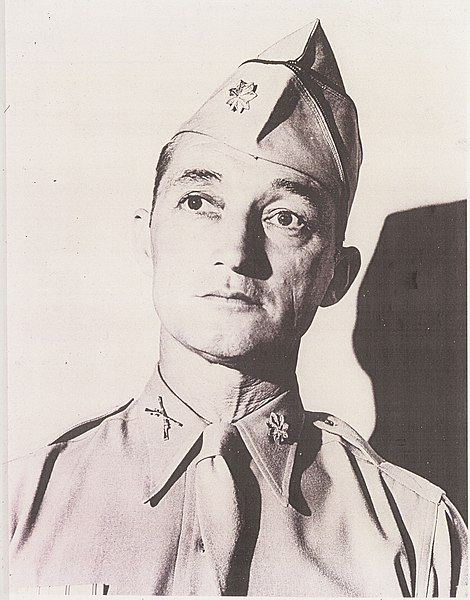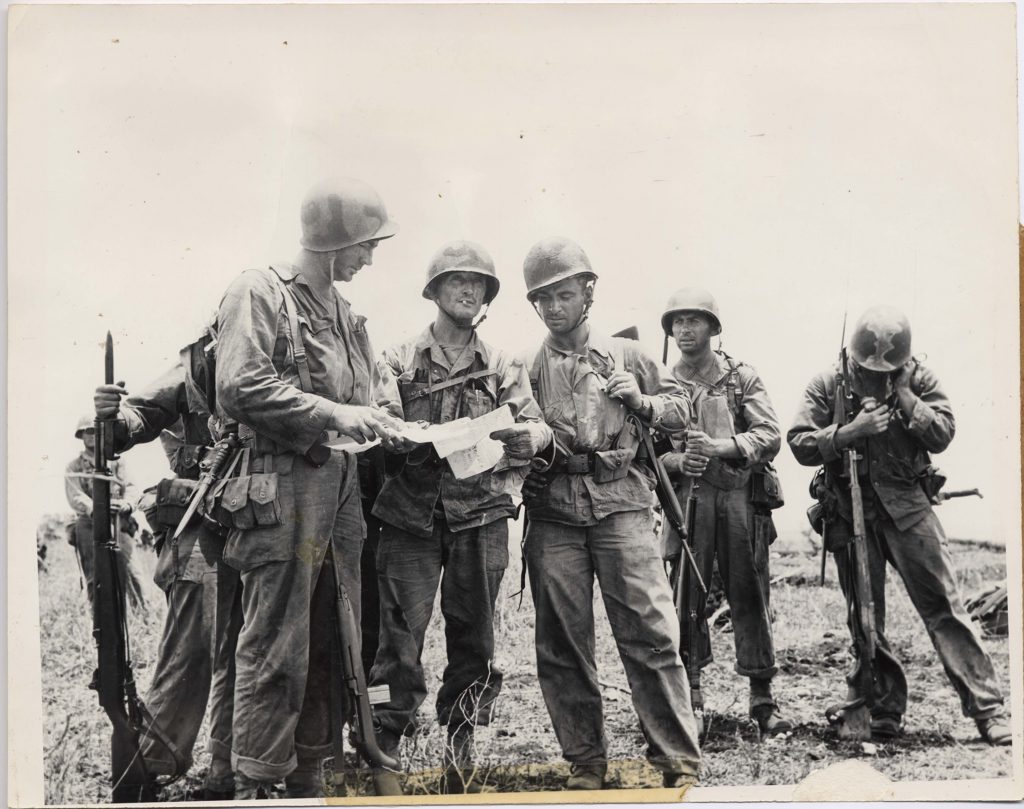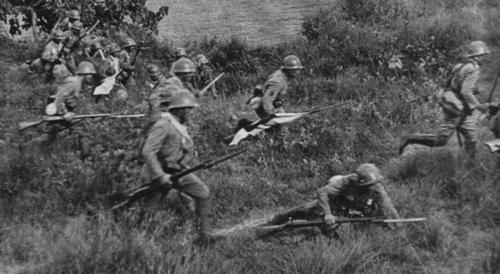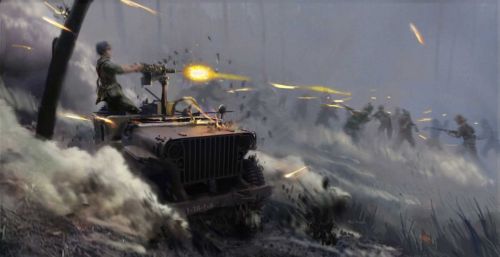
As the dark clouds of war gathered over America in the fall of 1940, the 105th Infantry Regiment of
They were conducting an exercise where they would run and on command drop to the ground in a position ready to fire their weapons. Some may have noticed the approach of Captain William J. O’Brien and his Sergeant Charles Whalen on their way to pick up the company’s payroll. Unlike most of his men, this was not O’Brien’s first war, he had enlisted as a private in 1917 and remained with N.Y. National Guard after W.W. I. Per Army regulation, O’Brien and his Sargent were both “spit ‘n polish” in Class A uniforms to present themselves to the paymaster. On observing the men, O’Brien exclaimed to his Sergeant, “Look at those (expletive), they are not doing it right!” He ran over to the men and began demonstrating the proper technique, covering himself in mud in the process. Once the men had the exercise down, he returned to his quarters to change into a new uniform. Besides the basics of the drill, the men learned what type of officer they had: one who would never ask them to do something he would not do himself. As Sergeant Whalen noted, O’Brien was a “Soldier’s Soldier.”
Four years later, O’Brien, now a Colonel and the Commander, 1st Battalion 105th Infantry, 27th Infantry Division would confirm that he was indeed a “Soldier’s Soldier.” The 105th, as part of the Army’s 27 infantry division along with two divisions of Marines, was part of the invasion of Saipan, the largest of the Mariana Islands. The naval portion of the attack is known to history as “The Battle of the Coral Sea.” The island was of critical strategic importance as airfields on Saipan would put the Japanese homeland well within the range of U.S. B-29 bombers. The Japanese knew this, and their commander vowed that his men would contest every inch of the island and inflict a terrible toll on U.S. forces.

On 21 June 1944, O’Brien and his men were pinned by intense Japanese fire. Three American tanks were ordered to eliminate the strong point. As the tanks approached, they too came under intense fire, causing the commanders to “button up” inside the tank turret, relying on the limited view through the tank’s periscopes for navigation and target identification. The tanks became disoriented and proceeded to fire into O’Brien’s men. With the same lack of hesitation he had shown when he saw his men doing a drill wrong, Col. O’Brien raced across the field as it was swept with enemy fire to climb onto the lead U.S. Tanks where O’Brien began pounding on the turret with the butt of his pistol till he had the commanders attention. Remaining outside the tank, fully exposed to enemy fire, O’Brien directed the tank’s assault until the threat from the strongpoint was neutralized. Dismounting the tank, O’Brien saw one of his men severely wounded; he picked him up and personally carried him out of the range of enemy fire.
There Bill O’Brien was right on top – the old nonchalant “Obie,” talking a mile a minute with a cigarette dangling from his lips. Obie, with his battalion, had just completed one of those very dangerous maneuvers which, when successful, go down with the great deeds of history.
Major Kenneth J. Dolan
On 28 June 1944, O’Brien’s battalion was ordered to take a ridge that the Japanese were bitterly defending. O’Brien decided to attempt the risky maneuver of splitting his force and attempt a coordinated attack on the enemy from both sides. Seeing the advanced element of one part of the assault stalled by intense Japanese opposition, Colonel O’Brien crossed 1,200 yards of sniper-infested underbrush to take command. Leaving some men to distract the enemy, O’Brien personally led four men through a narrow ravine behind the position eliminating it and capturing five machine guns and one 77mm artillery piece. When Major Kenneth J. Dolan linked up with O’Brien and his men, he recalled, “there Bill O’Brien was right on top – the old nonchalant “Obie,” talking a mile a minute with a cigarette dangling from his lips. Obie, with his battalion, had just completed one of those very dangerous maneuvers which, when successful, go down with the great deeds of history.”
By 6 July, the U.S. forces held 60% of Saipan, and the Japanese commander, Col. Takuji Suzuki, realized they could not hold the rest of the island for long. While U.S. intelligence wrongly believed that most of the defenders were dead, he still had approximately 5,000 men under his command. Resolved to inflict the most severe damage possible to the U.S. forces, and to avoid the dishonor of surrender, Col. Suzuki ordered a massed infantry attack known as Gyokusai in Japanese and a “Banzai charge” in the west as a form of honorable suicide. It would be the most massive such attack of the war.

After those Japanese soldiers too injured to walk committed ritual suicide, the remaining 4,500 Japanese launched their attack at 2:00 AM on 7 July, the point of attack being William O’ Brien and the men of the 105th. Maj McCarthy of the second battalion said the attack “reminded me of one of those old cattle stampede scenes of the movies. The camera is in a hole in the ground and you see the herd coming and then they leap up and over you and are gone. Only the Japs just kept coming and coming. I didn’t think they’d ever stop.” Bloody hand-to-hand fighting was in progress everywhere; there could be little hope of the men of the 105th being able to withstand such overwhelming numbers against a foe with no thought for their own lives other than to take as many Americans with them as possible. However, Col. O’Brien and the men of the 105th were equally determined to sell their lives dearly to buy time for the rest of the U.S. forces to organize a defense.
With casualties mounting and ammunition running low, Col. O’Brien refused to leave the front lines. He was seen striding up and down the line with a pistol in each hand firing at the enemy while encouraging his men to hold as long as possible. Even when shot in the shoulder, O’Brien continued to fire at the enemy while the medic simultaneously applied a bandage.
Obie was one of the boys that day. He died right on the frontline with us.
Sgt John G. Breen

When out of pistol ammunition, O’Brien grabbed a rifle from a wounded man and continued to fire while telling his men, “Don’t give a damn inch.” When that too ran out of ammunition, O’Brien ran to a Jeep that had a .50-caliber machine gun mount. As his men fell back to form a new line, they saw O’Brien standing up-right in the jeep, fully exposed, firing the machine gun as the Japanese human waved crashed on him. The next day after repulsing the Japanese attack, they found O’Brien’s body surrounded by thirty dead Japanese. As Sgt John G. Breen later recalled, “Obie was one of the boys that day. He died right on the frontline with us.”
LTC William J. O’Brien was awarded the Medal of Honor (posthumously) on 27 May 1945, in a ceremony at Rensselaer Polytechnic Institute, Troy, New York.
Memorial Day is a day we set aside to remember all those who gave the last full measure of devotion in defense of their country. We as Irish Americans can take particular pride and have a special duty, to remember the Irish, who were once accused of being incapable of being loyal Americans, are conspicuous on every American role of honor. We should never forget the Irish who wear their green every day on their graves in defense of our freedoms.
Neil F. Cosgrove, Division Historian
